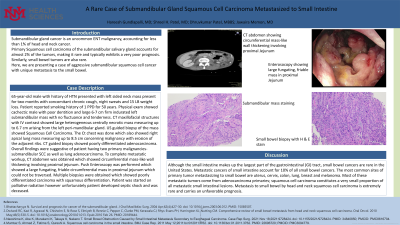Tuesday Poster Session
Category: Small Intestine
P4999 - A Rare Case of Submandibular Gland Squamous Cell Carcinoma Metastasized to Small Intestine
Tuesday, October 29, 2024
10:30 AM - 4:00 PM ET
Location: Exhibit Hall E

Has Audio

Hareesh Gundlapalli, MD
University of New Mexico
Albuquerque, NM
Presenting Author(s)
Hareesh Gundlapalli, MD1, Shreel H. Patel, MD2, Nirav B. Patel, MS3, Dhruvkumar Patel, MBBS4, Jawairia Memon, MD5
1University of New Mexico, San Antonio, TX; 2University of Texas Rio Grande Valley - Knapp Medical Center, Weslaco, TX; 3GCS Medical College, Hospital and Research Centre, Weslaco, TX; 4LSU Health Science Center, Shreveport, LA; 5UTHSCSA, San Antonio, TX
Introduction: Submandibular gland cancer is uncommon ENT malignancy, accounting for less than 1% of head neck cancer. Primary Squamous cell carcinoma of submandibular salivary gland accounts to almost 2% of the tumors, making it rare and typically exhibits a very poor prognosis. Similarly small bowel tumors are also rare. Here we are presenting a case of aggressive submandibular squamous cell cancer with unique metastasis to small bowel.
Case Description/Methods: 65-year-old male with history of HTN presented with left sided neck mass present for two months with concomitant chronic cough, night sweats and 15 LB weight loss. Patient reported smoking history of 1 PPD for 50 years. Physical exam showed cachectic male with poor dentition and large 6-7 cm firm indurated left submandibular mass with no fluctuance and tenderness. CT maxillofacial structures with IV contrast showed large heterogeneous centrally necrotic mass measuring up to 6.7 cm arising from the left peri-mandibular gland. US guided biopsy of the mass showed Squamous Cell Carcinoma. The Ct chest was done which also showed right apical lung mass measuring up to 8.5 cm concerning malignancy with erosion of the adjacent ribs. CT guided biopsy showed poorly differentiated adenocarcinoma. Overall findings were suggestive of patient having two primary malignancies- submandibular SCC as well as lung adenocarcinoma. To complete metastatic workup, CT abdomen was obtained which showed circumferential mass-like wall thickening involving proximal jejunum. Push Enteroscopy was performed which showed a large fungating, friable circumferential mass in proximal jejunum which could not be traversed. Multiple biopsies were obtained which showed poorly differentiated carcinoma with squamous differentiation. Patient was started on palliative radiation however unfortunately patient developed septic shock and was deceased.
Discussion: Although the small intestine makes up the largest part of the gastrointestinal (GI) tract, small bowel cancers are rare in the United States. Metastatic cancers of small intestine account for 10% of all small bowel cancers. The most common sites of primary tumor metastasizing to small bowel are uterus, cervix, colon, lung, breast and melanoma. Most of these metastatic tumors come from adenocarcinoma primaries; squamous cell carcinoma constitutes a very small proportion of all metastatic small intestinal lesions. Metastasis to small bowel by head and neck squamous cell carcinoma is extremely rare and carries an unfavorable prognosis.

Disclosures:
Hareesh Gundlapalli, MD1, Shreel H. Patel, MD2, Nirav B. Patel, MS3, Dhruvkumar Patel, MBBS4, Jawairia Memon, MD5. P4999 - A Rare Case of Submandibular Gland Squamous Cell Carcinoma Metastasized to Small Intestine, ACG 2024 Annual Scientific Meeting Abstracts. Philadelphia, PA: American College of Gastroenterology.
1University of New Mexico, San Antonio, TX; 2University of Texas Rio Grande Valley - Knapp Medical Center, Weslaco, TX; 3GCS Medical College, Hospital and Research Centre, Weslaco, TX; 4LSU Health Science Center, Shreveport, LA; 5UTHSCSA, San Antonio, TX
Introduction: Submandibular gland cancer is uncommon ENT malignancy, accounting for less than 1% of head neck cancer. Primary Squamous cell carcinoma of submandibular salivary gland accounts to almost 2% of the tumors, making it rare and typically exhibits a very poor prognosis. Similarly small bowel tumors are also rare. Here we are presenting a case of aggressive submandibular squamous cell cancer with unique metastasis to small bowel.
Case Description/Methods: 65-year-old male with history of HTN presented with left sided neck mass present for two months with concomitant chronic cough, night sweats and 15 LB weight loss. Patient reported smoking history of 1 PPD for 50 years. Physical exam showed cachectic male with poor dentition and large 6-7 cm firm indurated left submandibular mass with no fluctuance and tenderness. CT maxillofacial structures with IV contrast showed large heterogeneous centrally necrotic mass measuring up to 6.7 cm arising from the left peri-mandibular gland. US guided biopsy of the mass showed Squamous Cell Carcinoma. The Ct chest was done which also showed right apical lung mass measuring up to 8.5 cm concerning malignancy with erosion of the adjacent ribs. CT guided biopsy showed poorly differentiated adenocarcinoma. Overall findings were suggestive of patient having two primary malignancies- submandibular SCC as well as lung adenocarcinoma. To complete metastatic workup, CT abdomen was obtained which showed circumferential mass-like wall thickening involving proximal jejunum. Push Enteroscopy was performed which showed a large fungating, friable circumferential mass in proximal jejunum which could not be traversed. Multiple biopsies were obtained which showed poorly differentiated carcinoma with squamous differentiation. Patient was started on palliative radiation however unfortunately patient developed septic shock and was deceased.
Discussion: Although the small intestine makes up the largest part of the gastrointestinal (GI) tract, small bowel cancers are rare in the United States. Metastatic cancers of small intestine account for 10% of all small bowel cancers. The most common sites of primary tumor metastasizing to small bowel are uterus, cervix, colon, lung, breast and melanoma. Most of these metastatic tumors come from adenocarcinoma primaries; squamous cell carcinoma constitutes a very small proportion of all metastatic small intestinal lesions. Metastasis to small bowel by head and neck squamous cell carcinoma is extremely rare and carries an unfavorable prognosis.

Figure: This image demonstrates CT scan showing circumferential mass-like wall thickening involving proximal jejunum and small bowel biopsy.
Disclosures:
Hareesh Gundlapalli indicated no relevant financial relationships.
Shreel Patel indicated no relevant financial relationships.
Nirav Patel indicated no relevant financial relationships.
Dhruvkumar Patel indicated no relevant financial relationships.
Jawairia Memon indicated no relevant financial relationships.
Hareesh Gundlapalli, MD1, Shreel H. Patel, MD2, Nirav B. Patel, MS3, Dhruvkumar Patel, MBBS4, Jawairia Memon, MD5. P4999 - A Rare Case of Submandibular Gland Squamous Cell Carcinoma Metastasized to Small Intestine, ACG 2024 Annual Scientific Meeting Abstracts. Philadelphia, PA: American College of Gastroenterology.
